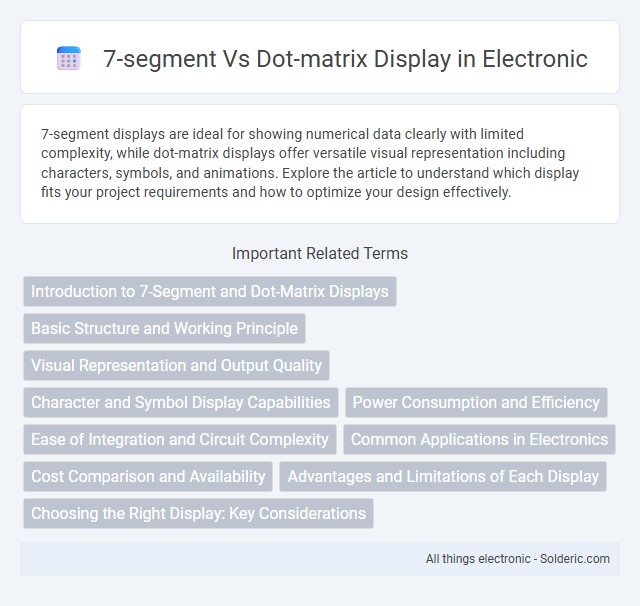7-segment displays are ideal for showing numerical data clearly with limited complexity, while dot-matrix displays offer versatile visual representation including characters, symbols, and animations. Explore the article to understand which display fits your project requirements and how to optimize your design effectively.
Comparison Table
| Feature | 7-Segment Display | Dot-Matrix Display |
|---|---|---|
| Display Type | Numeric and limited characters | Alphanumeric and graphics |
| Resolution | 7 segments per digit | Matrix of dots (e.g., 5x7, 8x8, 16x32) |
| Application | Clocks, calculators, simple counters | Scrolling text, complex symbols, animations |
| Cost | Low | Higher |
| Power Consumption | Lower | Higher |
| Complexity | Simple control circuit | Requires microcontroller or driver IC |
| Flexibility | Limited character set | Custom characters and graphics |
Introduction to 7-Segment and Dot-Matrix Displays
7-segment displays consist of seven individual LED or LCD segments arranged to form numerals, primarily used for displaying digits in devices like digital clocks and calculators. Dot-matrix displays feature a grid of LEDs or pixels that can create complex characters and graphics, enabling versatile text and image representations. The choice between 7-segment and dot-matrix displays depends on the application's need for simplicity and numeric output versus graphical and alphanumeric versatility.
Basic Structure and Working Principle
7-segment displays consist of seven individual LEDs arranged in a rectangular fashion, each segment lighting up to form numerals by selectively activating specific segments. Dot-matrix displays feature a grid of LEDs, typically arranged in rows and columns, allowing for the rendering of complex characters, symbols, and animations through precise control of individual dots. The working principle of 7-segment displays revolves around segment activation to represent numbers, while dot-matrix displays operate by lighting specific dots within the matrix to create detailed visual outputs.
Visual Representation and Output Quality
7-segment displays offer clear and precise visualization for numeric data through limited segments, making them ideal for simple digits but restricting graphic complexity. Dot-matrix displays consist of a grid of LED dots enabling full alphanumeric characters and intricate images, resulting in superior flexibility and higher output quality for detailed visual content. The dot-matrix's resolution and pixel control significantly enhance readability and customization compared to the rigid design of 7-segment units.
Character and Symbol Display Capabilities
7-segment displays are designed primarily for numeric characters and a limited set of symbols, making them ideal for digits 0-9 and some basic letters like A, b, C, d, E, and F. Dot-matrix displays offer a versatile grid of LEDs or pixels that can render a wide range of alphanumeric characters, symbols, and even complex graphics, significantly enhancing your display capabilities. Choosing between the two depends on whether your application requires simple numeric output or detailed, customizable text and symbols.
Power Consumption and Efficiency
7-segment displays consume less power compared to dot-matrix displays due to their simpler design and fewer active elements, making them more efficient for basic numeric output. Dot-matrix displays offer greater flexibility and detail by lighting multiple pixels individually but require more power to operate, affecting overall energy efficiency. You should choose a 7-segment display when prioritizing low power consumption and straightforward numeric visualization.
Ease of Integration and Circuit Complexity
7-segment displays offer easier integration in digital applications due to their simple interface and minimal wiring requirements, typically needing just 7 segments plus a decimal point. Dot-matrix displays, while more versatile for displaying varied characters and graphics, require more complex control circuits and additional driver ICs, increasing circuit complexity and design effort. The choice between the two hinges on the application's need for simplicity versus display versatility and complexity.
Common Applications in Electronics
7-segment displays are widely used in digital clocks, calculators, and basic electronic meters due to their simplicity and clear numeric representation. Dot-matrix displays excel in applications requiring complex graphics or alphanumeric characters, such as message boards, digital signage, and advanced instrumentation. Your choice between the two depends on whether you need straightforward numeric output or versatile visual information display.
Cost Comparison and Availability
7-segment displays are generally more cost-effective and widely available due to their simpler design and common use in basic numeric displays. Dot-matrix displays, while more flexible for rendering complex characters and graphics, tend to be pricier and have varied availability depending on resolution and size. Your choice depends on budget constraints and the need for detailed visual output.
Advantages and Limitations of Each Display
7-segment displays offer clear numerical representation with low power consumption, making them ideal for clocks, calculators, and simple digital readouts, but they are limited by their inability to display complex characters or graphics. Dot-matrix displays provide versatile alphanumeric and graphical capabilities, enabling detailed information and custom designs, yet they generally consume more power and require more complex control circuits. Your choice depends on whether you prioritize simplicity and efficiency with 7-segment or flexibility and detailed visualization with dot-matrix displays.
Choosing the Right Display: Key Considerations
Choosing between 7-segment and dot-matrix displays involves evaluating clarity, complexity, and application needs. 7-segment displays excel in presenting numerical data with high brightness and low power consumption, making them ideal for simple counters and timers. Dot-matrix displays offer greater versatility with the ability to render alphanumeric characters and graphics, suitable for dynamic messaging and detailed visual information.
7-segment vs Dot-matrix display Infographic

 solderic.com
solderic.com